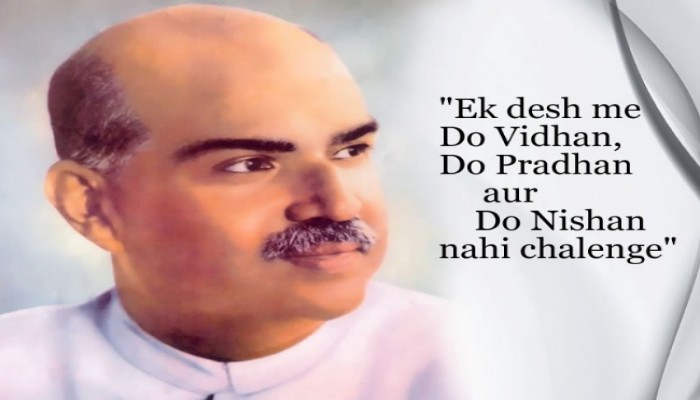Remembering the Supreme Sacrifice of Shyama Prasad Mukherjee for the cause of a United India on his death anniversary
- In History & Culture
- 10:33 AM, Jun 23, 2021
- Shwetank Bhushan
It is the death anniversary of a supreme pious soul - Dr Shyama Prasad Mukherjee, who sacrificed his life for the cause of a United India. Despite clear reasons to believe that his death in custody was politically motivated, unfortunately, it remains one of India's greatest unsolved death mysteries.
EARLY LIFE AND CAREER
Shyama Prasad Mukherjee was born on July 6 1901, in Calcutta. His father, Sir Ashutosh Mukherjee, was a judge of the High Court of Judicature at Fort William, Bengal, who was also Vice-Chancellor of the University of Calcutta. His mother was Lady Jogamaya Devi Mukherjee. Dr Mukherjee grew up to be "an introvert, rather insular, a reflective person; an emotional person", who needed someone else by his side to give him emotional support. He was seriously affected by the early death of his wife Sudha Devi and never remarried.
Shyama Prasad was elected a Fellow of Calcutta University at the age of 23. He was appointed member of the Syndicate of the Calcutta University in the place fallen vacant due to his father's death, and very soon it became apparent that the mantle of his illustrious father had fallen upon his broad shoulders in the educational sphere. He made the University his own, as his distinguished father had done before him, serving it with single-minded devotion.
He enrolled as an advocate in the Calcutta High Court in 1924 after his father had died. Subsequently, he left for England in 1926 to study at Lincoln’s Inn and became a Barrister-at-Law in 1927. There, he represented Calcutta University at the conference of Universities of the British Empire. At the age of 33, he became the youngest Vice-Chancellor of the University of Calcutta, for two successive terms – 1934-38, President, Post-graduate Councils in Arts and Science for consecutive years. He also held the Dean of Faculty of Arts, Member and then Chairman, Inter-University Board chair.
During the four years of his service as the Vice-Chancellor, Dr Mukherjee Prasad did not spare time, energy, health, convenience, or anything worth having in life. He initiated specific new departments and courses and developed and improved existing ones. In 1935, he became a Member of the Court and Council of the Indian Institute of Science, Bangalore. He also took an active interest in the development and smooth running of the institute.
POLITICAL CAREER
Shyama Prasad Mookerjee started his political career in 1929 as a member of the Legislative Council of Bengal, an Indian National Congress candidate representing Calcutta University but resigned the following year when Congress decided to boycott the legislature. Subsequently, he contested the election as an independent candidate and was elected.
He became the opposition leader when the Krishak Praja Party – Muslim League coalition was in power (1937-41) and joined the Progressive Coalition Ministry as Finance Minister headed by Fazlul Haq, but resigned within a year. It was the first and the last Hindu-Muslim joint ministry in Bengal.
Shyama Prasad gradually drifted into the fold of the Hindu Mahasabha, which galvanised his new life as an instrument for the service of the country in general and Hindus in particular. Shyama Prasad's association with the Hindu Mahasabha was the outcome of his strong reaction to the communal politics of the Muslim League, and the anti-national and disruptive forces let loose by it. Mookerjee was a political leader who felt the need to counteract the communalist and separatist Muslim League of Muhammad Ali Jinnah, demanding either exaggerated Muslim rights or a Muslim state of Pakistan.
He took a prominent part in the 21st session of the All India Hindu Mahasabha at Calcutta under the Presidentship of Veer Savarkar. In 1944 he became the President of Hindu Mahasabha. The then Governor of Bihar banned the Bhagalpur session of the Hindu Mahasabha. Dr Mookerjee, as President, proceeded to Bhagalpur to defy the ban and was arrested and detained under the Defense of India Rules and later released. Dr Mookerjee took part in Cripps Mission deliberations, first among the political parties to reject the Cripps offer, which supported the Muslim League's demand for the Partition of India on a communal basis. Dr Mookerjee then was one of the most vital voices to have opposed the Partition of India.
The United Bengal plan conceived
The most striking aspect of the Partition of Bengal in 1905 by Lord Curzon was the fact that the Bengali Hindus who had vociferously opposed it then were the ones who demanded the division of the province on religious lines less than half a century later. Bengal politics dramatically changed in 1932 with the introduction of the Communal Award.
In the meantime, however, Suhrawardy and few other top Bengal politicians came up with an alternative for the Partition. Huseyn Shaheed Suhrawardy had realised that the Partition would mean economic disaster for East Bengal since all coal mines, jute mills, and industrial plants would go to the western part of the state. As per the united Bengal plan of the Muslim League, Bengal would be a separate nation independent of India and Pakistan.
THE HORRIFIC CALCUTTA KILLING
The communal clashes that had started in 1905 reached their peak by 1947. On the failure of the Cabinet Mission to solve the problem relating to the transfer of power to Indian Leaders, the Muslim League, under the instruction of Jinnah and "guidance" of H. S. Suhrawardy, launched the "direct action" against Hindus in Calcutta on August 16 1946. It was followed by a gruesome series of massacres, brutal rapes, abduction, forced conversions of Hindus and looting and arson of Hindu properties - a year before India’s independence from British rule.
Mookerjee’s views were strongly affected by the Bengal genocide of Hindus. The Hindu Mahasabha under Dr Mookerjee spearheaded a fierce attack against the united Bengal scheme. He thought it would force Hindus to live under Muslim domination. He argued that according to Jinnah, Hindus and Muslims are two separate nations and Muslims must have their state. Hence, Hindus in Bengal may well demand that they not be compelled to live under Muslim domination. Thus, his efforts protected the interests of the Hindus and a portion of Bengal, now named West Bengal, saved from the Muslim League's clutches and remained with the Indian Union.
POST-INDEPENDENCE CAREER
Prime Minister Jawaharlal Nehru inducted him in the Interim Central Government as a Minister for Industry and Supply. Dr Mukherjee was widely respected across political quarters.
Dr Mukherjee wanted to hold Pakistan directly responsible for the terrible influx of millions of Hindu refugees from East Pakistan, who had left the state fearing religious suppression and persecution aided by the state. Dr Mookherjee felt that Nehru had a very soft attitude towards Pakistan. He had no courage to protect the interests of Hindus left in Western and East Pakistan. Due to Nehru's continued disregard for the displaced, Dr Mukherjee finally resigned from Nehru’s Cabinet on April 8 1950.
Soon he became one of the most vocal critics of Nehru and associated himself with the Jammu and Kashmir issue. After consultation with RSS leader Madhav Sadashiv Golwalkar, Dr Mukherjee founded the Bharatiya Jana Sangh on October 21, 1951, at Delhi and became its first President. In the 1952 General Elections to the Parliament of India, Dr Mookerjee and Bharatiya Jana Sangh won 3 seats.
Jan Sangh, under Dr Mukherjee, criticised favouritism to India's Muslims by the Nehru administration and promoted free-market economics as opposed to socialism in Nehru's economic and social policies. Jana Sangh, since its inception, also favoured a Uniform Civil Code and proposed to ban cow slaughter and end the special status of Muslim-majority, Jammu and Kashmir. No one, including the President of India, could enter Kashmir without Kashmir's Prime Minister's permission.
ARTICLE 370
Shyama Prasad Mookerjee was convinced that special status to Jammu & Kashmir was an injustice to its people but will also cause the Balkanisation of India. He remained a lifelong opponent of Article 370. This Article bled our motherland culturally, politically, and socially and led to the destruction of the Hindu way of life in Kashmir. It told us that some Indians were more equal than others for seventy years, martyred many of our soldiers. But the spineless politics that dominated the Indian landscape, where Indians, especially Hindus, had to kneel in front of their masters, ensured it could not be questioned. Abrogation of Article 370 was the best tribute the Bhartiya Janata Party leaders could have given its founder.
LAST DAYS
To oppose this, he made the call for “Ek Desh me do Vidhan, do Pradhan aur Do Nishan Nahin chalenge.”
Shyama Prasad Mukherjee went to Kashmir in 1953 on a hunger strike to protest the law prohibiting Indian citizens from settling in a state in their own country and the need to carry ID cards and was arrested on May 11 after entering Jammu & Kashmir. He was kept under detention under the rule of Sheikh Abdullah, a close friend of Jawaharlal Nehru. In less than two months under detention, he passed away on June 23, 1953, under mysterious circumstances.
His death in custody raised general suspicions across the country. There were widespread demands for an independent enquiry, including earnest requests from his mother, Jogmaya Devi, to the then Prime Minister of India, Pandit Jawaharlal Nehru. But Pandit Nehru did not order an inquiry. All of this raises a set of questions:
1. Why was he not arrested before getting into Kashmir if he did not have the required permit?
2. Why did Nehru not meet with him or try to get him freed since Abdullah listened to him?
3. Why was his communication with the external world being censored?
4. Why did Nehru turn down the demand for independent inquiry?
The above questions compel one to think of a deeper conspiracy hatched by the Jawaharlal Nehru-led central government and Sheikh Abdullah-led Jammu and Kashmir government. We might never know the truth unless some hitherto unknown information comes to light.
Former Prime Minister Atal Bihari Vajpayee, in July 2004, reportedly said: “Dr Mookerjee was originally supposed to be arrested in Punjab before he could enter Jammu and Kashmir. But that did not happen. Later, we realised that the Jammu and Kashmir government and the Nehru government had hatched a conspiracy, as it was decided that Mookerjee would be allowed to enter the state but not allowed to leave. Sheikh Abdullah Government was told that he should not be allowed to return," he was widely reported as saying.
To foil the evil design of Sheikh Abdullah, Dr Mukherjee not only gave up his precious life for the sake of the country but forced the Government of India to accept that one country cannot have two constitutions, two Prime Ministers and two National Emblems.
Dr Mukherjee will be regarded as having died a martyr’s death in Kashmir. It is a grim tragedy that a great patriot of his stature died a premature and unseemly death while in detention without trial. It is an issue linked to Dr Mookerjee that is still pending.
Image Source: Organiser
Disclaimer: The opinions expressed within this article are the personal opinions of the author. MyIndMakers is not responsible for the accuracy, completeness, suitability, or validity of any information on this article. All information is provided on an as-is basis. The information, facts or opinions appearing in the article do not reflect the views of MyindMakers and it does not assume any responsibility or liability for the same.







Comments